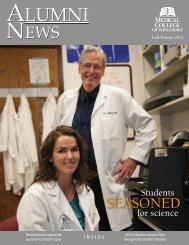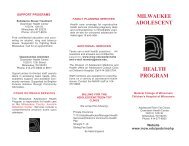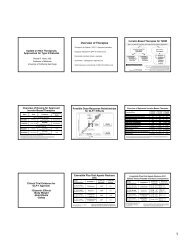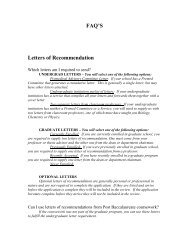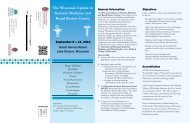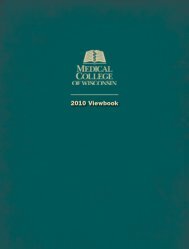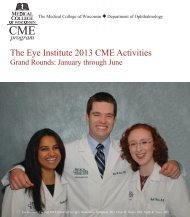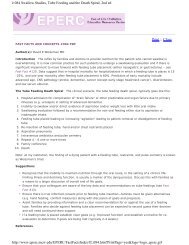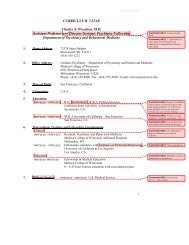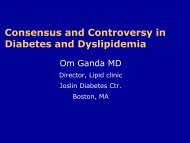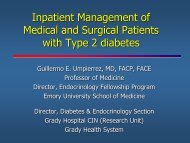Management of Advancing Diabetic Nephropathy - Medical College ...
Management of Advancing Diabetic Nephropathy - Medical College ...
Management of Advancing Diabetic Nephropathy - Medical College ...
You also want an ePaper? Increase the reach of your titles
YUMPU automatically turns print PDFs into web optimized ePapers that Google loves.
<strong>Management</strong> <strong>of</strong> <strong>Advancing</strong> <strong>Diabetic</strong><br />
<strong>Nephropathy</strong><br />
6 th Annual Diabetes Symposium <strong>of</strong> Wisconsin<br />
May 16, 2013<br />
Mark E. Molitch, M.D.<br />
Division <strong>of</strong> Endocrinology, Metabolism & Molecular Medicine<br />
Northwestern University Feinberg School <strong>of</strong> Medicine<br />
Chicago, Illinois
Disclosures<br />
• Research Support<br />
– Novartis<br />
– Novo Nordisk<br />
– Eli Lilly<br />
– Reata<br />
– San<strong>of</strong>i-Aventis<br />
• Consulting<br />
– Novartis<br />
– Novo Nordisk<br />
– Eli Lilly<br />
– Abbott<br />
– Janssen
Incident counts & adjusted rates,<br />
by primary diagnosis<br />
Incident ESRD patients; rates adjusted for age, gender, & race.<br />
USRDS - 2008
Adjusted five-year survival, by modality<br />
& primary diagnosis: 1997-2001<br />
incident dialysis patients & patients receiving a first transplant in the calendar year. All probabilities adjusted for age, gender, &<br />
race; overall probabilities also adjusted for primary diagnosis. All ESRD patients, 2005, used as reference cohort. Modality<br />
determined on first ESRD service date; excludes patients transplanted or dying during the first 90 days. Five-year survival<br />
probabilities noted in parentheses. Dialysis patients followed from day 90 after initiation; transplant patients followed from the<br />
transplant date.<br />
USRDS - 2008
Is the Answer More Available Kidneys<br />
for Transplantation?
Or<br />
Can We Decrease the Number <strong>of</strong> People with<br />
End Stage <strong>Diabetic</strong> Kidney Disease?<br />
• Prevent the development <strong>of</strong> diabetes<br />
– The DPP has shown that it is possible<br />
• Decrease the proportion <strong>of</strong> people with<br />
diabetes who develop nephropathy<br />
• Decrease the rate <strong>of</strong> progression <strong>of</strong><br />
nephropathy
Incidence <strong>of</strong> <strong>Diabetic</strong> End-Stage<br />
Renal Disease per 100,000 People<br />
with Diabetes, U.S., 1980 - 2008<br />
National Diabetes Surveillance System, U.S. Renal Data System, National Health Interview Survey
GFR (ml/min/m<br />
Urinary albumin<br />
(mg/24h)<br />
2<br />
140<br />
120<br />
100<br />
80<br />
60<br />
40<br />
20<br />
0<br />
Natural History <strong>of</strong> <strong>Diabetic</strong><br />
<strong>Nephropathy</strong><br />
GFR<br />
Albumin<br />
Albuminuria<br />
Microalbuminuria<br />
0 5 10 15 20 25 30<br />
Duration <strong>of</strong> Diabetes (years)<br />
600<br />
500<br />
400<br />
300<br />
200<br />
100<br />
0<br />
Microalbuminuria – 30 – 299 mg/g creatinine (spot) or 30-299 mg/24h<br />
Albuminuria - > 300 mg/g creatinine (spot) or > 300 mg/24h
Kramer et al., JAMA 2003;289:3273<br />
Frequency <strong>of</strong> Albuminuria and Retinopathy in<br />
Subjects with GFR above and below<br />
60 ml/min/m 2 in Subjects with Type 2 Diabetes<br />
> 40 Years <strong>of</strong> Age (NHANES III)<br />
GFR > 60 GFR < 60<br />
Microalbuminuria 32% 45%<br />
Macroalbuminuria 5% 19%<br />
Retinopathy 15% 28%<br />
No retinopathy or<br />
albuminuria<br />
30%
Albumin Excretion Rates Preceding Diagnosis<br />
<strong>of</strong> Impaired Kidney function ([Sustained] GFR<br />
< 60 ml/min/1.73m 2 ) in DCCT/EDIC Subjects<br />
39%<br />
N=203 N=89
Estimates <strong>of</strong> the mean levels <strong>of</strong> eGFR at each DCCT-EDIC<br />
follow-up year among subjects currently with normal AER, or<br />
microalbuminuria or albuminuria at that time<br />
Normal<br />
Allbuminuria<br />
Microalbuminuria<br />
Molitch et al., Diabetes Care 2010; 33:1536
Equations for Estimating GFR<br />
Abbreviated MDRD Study Equation<br />
GFR (mL/min/1.73 m 2 ) = 186.3 SCr -1.154 Age -0.203<br />
0.742 (if female) 1.210 (if African American)<br />
Cockcr<strong>of</strong>t-Gault Equation<br />
C cr =<br />
(mL/min)<br />
(140 – Age) Weight in kg<br />
72 SCr<br />
0.85 if female<br />
MDRD = Modification <strong>of</strong> Diet in Renal Disease; C cr = creatinine clearance.<br />
Levey et al. Ann Intern Med. 2003;139:137-147.
GFR Calculator<br />
(just type MDRD<br />
Into search space<br />
In Google)<br />
The formula used to estimate GFR in this application is appropriate for adults only.<br />
Available at: www.kidney.org/kls/pr<strong>of</strong>essionals/gfr_calculator.cfm/
CKD Progresses in Stages Defined by<br />
Kidney Function: GFR<br />
CKD<br />
Stage<br />
Description<br />
GFR<br />
(mL/min/1.73 m 2 )<br />
1 Kidney damage with normal<br />
or GFR<br />
2 Kidney damage with<br />
mild GFR<br />
3a<br />
3b<br />
90<br />
60-89<br />
Moderate GFR 45-59<br />
30-44<br />
4 Severe GFR 15-29<br />
5 Kidney failure
Good Glycemic Control (Lower HbA 1c )<br />
Reduces Complications<br />
DCCT<br />
Kumamoto<br />
UKPDS<br />
HbA 1c<br />
9 7%<br />
9 7%<br />
8 7%<br />
Retinopathy<br />
76%<br />
69%<br />
17-21%<br />
<strong>Nephropathy</strong><br />
54%<br />
70%<br />
24-33%<br />
Neuropathy<br />
60%<br />
-<br />
-<br />
Macrovascular<br />
disease<br />
41%*<br />
-<br />
16%*<br />
* not statistically significant<br />
DCCT Study Group: N Engl J Med 329:977-86, 1993<br />
Ohkubo Y: Diabetes Res Clin Prac 28:103-17, 1995<br />
UKPDS Study Group: Lancet 352:837-53, 1998
Cumulative Incidence <strong>of</strong> Albuminuria* in Type 1<br />
Diabetes in the DCCT/EDIC Study and the Pittsburgh<br />
Epidemiology <strong>of</strong> Diabetes Complications Study<br />
25%<br />
17%<br />
9%<br />
*>300 mg/24h<br />
DCCT/EDIC Research Group. Arch Intern Med 2009;169:1307
Relative Risk<br />
DCCT<br />
Relationship <strong>of</strong> HbA 1c to Risk <strong>of</strong> Microvascular<br />
Complications<br />
15<br />
13<br />
11<br />
9<br />
Retinopathy<br />
<strong>Nephropathy</strong><br />
Neuropathy<br />
Microalbumin<br />
7<br />
5<br />
3<br />
1<br />
6 7 8 9 10 11 12<br />
HbA 1c (%)<br />
Skyler. Endocrinol Metab Clin. 1996;25:243-254, with permission.<br />
3-3
Cumulative Incidence <strong>of</strong> Impaired eGFR<br />
(sustained
Primary & Secondary GFR Outcomes<br />
Number <strong>of</strong> Events<br />
Relative Risk Reduction<br />
Intensive<br />
Therapy<br />
Conventional<br />
Therapy<br />
Risk Reduction<br />
(%, 95% CI)<br />
P-<br />
value<br />
Impaired GFR* 24 46 50 (18, 69) 0.006<br />
eGFR < 45 mL/min/1.73m 2 24 39 40 (1, 64) 0.045<br />
eGFR < 30 mL/min/1.73m 2 13 23 44 (-9, 72) 0.088<br />
End stage renal disease 8 16 51 (-14, 79) 0.098<br />
Impaired GFR* or death 53 80 37 (10, 55) 0.011<br />
• Sustained eGFR < 60 mL/min/1.73m 2 (primary outcome <strong>of</strong> this study)<br />
• Risk reduction is relative difference in risk <strong>of</strong> impaired GFR (in percent) comparing<br />
intensive to conventional diabetes therapy<br />
N Engl J Med 2011;365:2366
GFR (ml/min)<br />
<strong>Management</strong> <strong>of</strong> Progressing <strong>Diabetic</strong><br />
Kidney Disease and Its Complications<br />
140<br />
120<br />
100<br />
80<br />
60<br />
40<br />
↑Glucose<br />
CVD<br />
↑ BP<br />
↑ LDL<br />
2 HPT<br />
Anemia<br />
20<br />
0<br />
0 2 4 6 9 10 12 14 16 18 20<br />
ESRD<br />
Years
Annual Transition Rates In Patients with<br />
Type 2 Diabetes in the UKDPS<br />
No <strong>Nephropathy</strong><br />
2.0%<br />
Microalbuminuria<br />
2.8%<br />
Albuminuria<br />
2.3%<br />
Elevated Creatinine or<br />
Renal Replacement Rx<br />
1.4%<br />
3.0%<br />
4.6%<br />
19.2%<br />
Death<br />
Adler et al., Kidney Intl 2003;63:225
Estimated Event Rate (%)<br />
Cardiovascular Outcomes Worsen With CKD<br />
Progression: 3-Y Follow-Up by eGFR Levels<br />
60<br />
50<br />
P
Control <strong>of</strong> BP Slows Decline <strong>of</strong><br />
GFR in Patients with <strong>Diabetic</strong><br />
110<br />
<strong>Nephropathy</strong><br />
100<br />
ΔGFR: 0.94 ml/min/month<br />
GFR (min/1.73m 2<br />
90<br />
80<br />
70<br />
Before<br />
Start <strong>of</strong> antihypertensive<br />
treatment<br />
ΔGFR: 0.29<br />
ml/min/month<br />
60<br />
During<br />
-2 -1 0 1 2 3<br />
Years<br />
Parving et al., 1987
GFR (ml/min/year)<br />
Relationship Between Achieved BP and GFR<br />
MAP (mm Hg)<br />
0<br />
-2<br />
-4<br />
-6<br />
-8<br />
-10<br />
-12<br />
-14<br />
95 98 101 104 107 110 113 116 119<br />
130/80 140/90<br />
r=0.69; p
Pohl et al., JASN 2005;16:3027<br />
Relative Risk <strong>of</strong> Reaching<br />
a Renal End Point<br />
(doubling <strong>of</strong> serum<br />
creatinine or SCr > 6.0 or<br />
RRT) and All Cause<br />
Mortality by Level <strong>of</strong><br />
Achieved SBP in the<br />
Irbesartan <strong>Diabetic</strong><br />
<strong>Nephropathy</strong> Trial (IDNT)
Pohl et al., JASN 2005;16:3027<br />
Relative Risk <strong>of</strong> Reaching<br />
a Renal End Point<br />
(doubling <strong>of</strong> serum<br />
creatinine or SCr > 6.0 or<br />
RRT) and All Cause<br />
Mortality by Level <strong>of</strong><br />
Achieved SBP in the<br />
Irbesartan <strong>Diabetic</strong><br />
<strong>Nephropathy</strong> Trial (IDNT)
ACCORD BP Study:<br />
Primary and Secondary Outcomes<br />
• Patients with T2D and hypertension (N = 4733)<br />
• Random assignment<br />
• Intensive therapy: target SBP < 120 mm Hg<br />
• Standard therapy: target SBP < 140 mm Hg<br />
• 1 outcome: nonfatal MI, nonfatal stroke, death from CV causes<br />
• Mean follow-up = 4.7 y<br />
Outcome Intensive Standard HR P-value<br />
SBP after 1 year (mmHg) 119.3 133.5 NR NR<br />
1 outcome (annual rate) 1.87 2.09 0.88 .20<br />
Death from any cause<br />
(annual rate)<br />
1.28 1.19 1.07 .55<br />
Stroke (annual rate) 0.32 0.53 0.59 .01<br />
AEs (rate) 3.3 1.3 NR
ADA Standards <strong>of</strong> Care 2013:<br />
Recommendations for Managing<br />
Hypertension in Diabetes<br />
• Control BP to prevent or slow CVD and CKD in<br />
people with diabetes<br />
• BP goal: < 140/80 mm Hg<br />
• Therapy<br />
– SBP 130–139<br />
• Lifestyle therapy alone<br />
– SBP ≥ 140 or DBP ≥ 80 mm Hg<br />
• Pharmacologic and lifestyle therapy<br />
• Include ACE-I or ARB<br />
• Add more drugs if necessary<br />
• Multiple drug therapy generally required<br />
Diabetes Care. 2013;36(suppl 1):S11- S66.
Effects <strong>of</strong> ACE Inhibitors and ARBS on Mortality and Renal<br />
Outcomes in <strong>Diabetic</strong> <strong>Nephropathy</strong>: Systematic Review<br />
• ACE Inhibitors compared to placebo: 20 Trials with 2838<br />
patients<br />
– All cause mortality: RR 0.79 (CI 0.63-0.99)<br />
• ACE Inhibitors compared to placebo: 9 Trials with 1907<br />
patients<br />
– ESRD: RR 0.64 (0.40-1.03)<br />
– Doubling <strong>of</strong> Creatinine: RR 0.60 (0.34-1.05)<br />
– Progression micro- to macroalbuminuria: RR 0.45 (0.28-0.71)<br />
• ARBs compared to placebo: 4 trials with 3329 patients<br />
– All cause mortality: RR 0.99 (0.85-1.17) (LIFE Study not included)<br />
• ARBs compared to placebo: 3 trials with 3251 patients<br />
– ESRD: RR 0.78 (0.67-0.91)<br />
– Doubling <strong>of</strong> Creatinine: RR 0.79 (0.67-0.93)<br />
– Progression micro- to macroalbuminuria: RR 0.49 (0.32-0.75)<br />
Strippoli et al., BMJ 2004:329:828-828
Lack <strong>of</strong> Benefit <strong>of</strong> Enalapril (20mg) or Losartan (100mg) in<br />
Preventing the Initial Development <strong>of</strong> Microalbuminuria in<br />
Normotensive Subjects with Type 1 Diabetes<br />
Mauer M et al. N Engl J Med 2009;361:40-51
Lack <strong>of</strong> Benefit <strong>of</strong> Candesartan (32mg) in Preventing the<br />
Initial Development <strong>of</strong> Microalbuminuria in Normotensive<br />
Subjects with Type 1 and Type 2 Diabetes (DIRECT Studies)<br />
Bilous, R. et. al. Ann Intern Med 2009;151:11
Average Number <strong>of</strong> Antihypertensive Medications<br />
Needed per Patient to Achieve Target Systolic Blood<br />
Pressure (SBP) Goals in Various Trials<br />
TRIAL (SBP Achieved)<br />
ALLHAT (138 mmHG)<br />
IDNT (138 mmHg)<br />
RENAAL (141 mmHg)<br />
UKPDS (144 mmHg)<br />
ABCD (132 mmHg)<br />
MDRD (132 mmHg)<br />
HOT (138 mmHg)<br />
AASK (128 mmHg)<br />
0 1 2 3 4<br />
Number <strong>of</strong> Antihypertensive Medications<br />
Bakris, Am J Med 2004;116(Suppl5A):30S
Event Rates Plotted against LDL Cholesterol Levels<br />
during Statin Therapy in Secondary-Prevention Studies<br />
LaRosa, J. C. et al. N Engl J Med 2005;352:1425
Heart Protection Study<br />
Cardiovascular Benefits <strong>of</strong> Simvastatin in those<br />
with Normal and Abnormal Renal Function<br />
% <strong>of</strong> Patients with Cardiac Events<br />
50<br />
45<br />
40<br />
35<br />
30<br />
25<br />
20<br />
15<br />
10<br />
5<br />
0<br />
Placebo<br />
Simvastatin<br />
23.9 24.3<br />
19.5 19.1<br />
44.6<br />
34.5<br />
37.5<br />
26.4<br />
168 142 515 504<br />
Diabetes No Diabetes Diabetes No Diabetes<br />
Creatininine<br />
Creatinine<br />
< 1.24 mg/dl<br />
1.24 (1.47) – 2.26 mg/dl<br />
(GFR >47)<br />
GFR 47(52) – 23 (32)<br />
< 1.47 mg/dl (GFR >52)<br />
HPS Collaborative Group: Lancet 2003;361:2005
Cumulative incidence (%)<br />
4D Study: Primary Composite End Point (Cardiac<br />
Death, Nonfatal MI & Stroke)<br />
1255 subjects with Type 2 diabetes receiving hemodialysis<br />
60<br />
50<br />
Relative Risk Reduction 8 %<br />
(95 % CI: 0.77-1.10, P=0.37)<br />
Placebo<br />
40<br />
30<br />
20<br />
10<br />
Atorvastatin 20 mg<br />
Placebo<br />
Atorvastatin<br />
0<br />
0 1 2 3 4 5 5.5 years<br />
Placebo 636 532 383 252 136 51 29<br />
Atorvastatin 619 515 378 252 136 58 19<br />
Median follow-up time <strong>of</strong> 4 years<br />
Years from Randomization<br />
Wanner et al., NEJM 2005;353:238
Aurora Study<br />
2776 Patients with ESRD (19.2% with DM) assigned to Rosuvastatin 10 mg<br />
vs. Placebo, Primary Endpoint: CVD death, nonfatal MI or nonfatal stroke<br />
43% reduction in LDL<br />
Fellstrom B et al. N Engl J Med 2009;360:1395-1407
SHARP: Major Atherosclerotic Events<br />
by renal status at randomization<br />
Eze/simv<br />
(n=4650)<br />
Placebo<br />
(n=4620)<br />
Risk ratio & 95% CI<br />
Non-dialysis (n=6247) 296 (9.5%) 373 (11.9%)<br />
Dialysis (n=3023) 230 (15.0%) 246 (16.5%)<br />
Any patient 526 (11.3%) 619 (13.4%) 16.5% SE 5.4<br />
reduction<br />
(p=0.0022)<br />
No significant heterogeneity between<br />
non-dialysis and dialysis patients (p=0.25)<br />
0.6 0.8 1.0 1.2 1.4<br />
Eze/simv<br />
better<br />
Placebo<br />
better
Summary <strong>of</strong> Lipids and CKD<br />
• Patients with diabetes and CKD are at very high risk <strong>of</strong><br />
CVD<br />
• CVD events can be significantly reduced with statins in<br />
patients with diabetes<br />
• CVD events can be significantly reduced with statins in<br />
patients with CKD prior to dialysis<br />
• CVD events cannot be significantly reduced with<br />
statins in patients with diabetes undergoing dialysis<br />
– Does this mean we should stop statins when<br />
patients go on dialysis? Probably not<br />
– But no evidence to support the NEW institution <strong>of</strong><br />
statins in a dialysis patient<br />
• The LDL goal for treatment <strong>of</strong> patients with diabetes<br />
and CKD prior to dialysis should be 70 mg/dl<br />
• Risks <strong>of</strong> rhabdomyolysis with statins are low -
Vitamin D and Kidney Disease<br />
OH<br />
OH<br />
HO<br />
HO<br />
HO<br />
OH<br />
Vitamin D 3<br />
25-Hydroxyvitamin D 3<br />
25(OH)D<br />
Storage Form<br />
1,25-Dihydroxyvitamin D 3<br />
1,25(OH) 2 D 3 or Calcitriol<br />
Active Form
Mineral Metabolism and Secondary HPT<br />
in Patients With CKD<br />
Reduced Renal Mass<br />
Decreased Serum<br />
1,25(OH) 2 D<br />
Increased Serum<br />
Phosphate<br />
Hypocalcemia<br />
Increased PTH Secretion<br />
Decreased<br />
Vitamin D<br />
Receptors<br />
Decreased<br />
Ca-sensing<br />
Receptors<br />
Parathyroid Glands<br />
CKD = chronic kidney disease; HPT = hyperparathyroidism; PTH = parathyroid hormone; 1,25(OH) 2 D = calcitriol.
Prevalence <strong>of</strong> Abnormal PTH, Hyperphosphatemia<br />
and Hypocalcemia by eGFR<br />
90<br />
80<br />
70<br />
60<br />
50<br />
40<br />
30<br />
20<br />
10<br />
0<br />
PTH > 65 pg/mL<br />
Phosphorus > 4.6 mg/dL<br />
Calcium < 8.4 mg/dL<br />
>80 79-70 69-60 59-50 49-40 39-30 29-20
Percentage <strong>of</strong> Patients<br />
Prevalence <strong>of</strong> 1,25(OH) 2 D 3 and 25(OH)D 3<br />
Deficiency/Insufficiency<br />
100%<br />
80%<br />
25(OH) Vitamin D
Bone Mineral Density, Z-Score<br />
Evidence <strong>of</strong> Renal Osteodystrophy:<br />
Bone Loss in CKD Stages 2-4<br />
0.00<br />
PTH 120 pg/mL<br />
Spine Hip Arm<br />
-0.25<br />
-0.50<br />
-0.75<br />
-1.00<br />
-1.25<br />
-1.50<br />
-1.75<br />
*<br />
*<br />
-2.00<br />
-2.25<br />
*P
Observed/Expected<br />
Incidence <strong>of</strong> Hip Fracture*<br />
Hip-Fracture Rate in Patients on Dialysis:<br />
Comparison With the General Population<br />
100<br />
80<br />
Overall<br />
Male relative risk = 4.4x<br />
Female relative risk = 4.4x<br />
60<br />
40<br />
20<br />
0<br />
Additional Factors Influencing Renal<br />
Osteodystrophy in Patients<br />
With Chronic Kidney Disease<br />
• Glucocorticoid therapy<br />
• Female Hypogonadism (Estrogen Deficiency)<br />
• Menopause<br />
• Male hypogonadism<br />
• Metabolic acidosis<br />
Eknoyan et al for the NKF. Am J Kidney Dis. 2003;42(4 suppl 3):1-201.
Recommended Goals for Hormone and<br />
Mineral Metabolism in CKD Stages 3 and 4<br />
Parameter<br />
Recommendation<br />
iPTH (pg/mL) 35-70 in CKD Stage 3; 70-110 in CKD Stage 4<br />
Ca (mg/dL) Within normal range <strong>of</strong> your lab (8.5-10.2)<br />
P (mg/dL) 2.7-4.6<br />
Ca P (mg 2 /dL 2 )
Activated Vitamin D Compounds for the<br />
Treatment <strong>of</strong> Secondary Hyperparathyroidism<br />
H 3 C<br />
CH 3<br />
OH<br />
First Generation<br />
(discovery 1971)<br />
HO<br />
CH 2<br />
OH<br />
Calcitriol<br />
CH 3<br />
Second Generation<br />
(discovery 1974)<br />
H 3 C<br />
HO<br />
CH 2<br />
OH<br />
CH 3<br />
CH 3<br />
H 3 C<br />
HO<br />
CH 3<br />
CH 3<br />
CH 2<br />
OH<br />
Alfacalcidol*<br />
H 3 C<br />
CH 3 CH 3<br />
CH OH<br />
3<br />
Doxercalciferol<br />
Third Generation<br />
(discovery 1985)<br />
Paricalcitol<br />
*Not available in the United States. Dusso et al. Semin Nephrol. 2004;24:10<br />
HO<br />
OH
Change in iPTH 1-84 (%)<br />
Change in Spine (%)<br />
Vitamin D Compound Alfacalcidol* Suppresses<br />
PTH and Improves BMD in CKD Stages 3 and 4<br />
100<br />
80<br />
6<br />
Alfacalcidol (n = 16)<br />
Placebo (n = 15)<br />
60<br />
4<br />
40<br />
20<br />
2<br />
† †<br />
0<br />
-20<br />
-40<br />
-60<br />
†<br />
†<br />
†<br />
†<br />
‡<br />
‡<br />
‡<br />
‡<br />
0 3 6 9 12 15 18<br />
0<br />
-2<br />
-4<br />
0 6 12 18<br />
Follow-Up (mo)<br />
BMD = bone mineral density; *Alfacalcidol is available outside the United States; † Significant differences<br />
between groups; ‡ Significant changes from baseline in each group.<br />
Rix et al. Nephrol Dial Transplant. 2004;19:870-876.
Secondary Hyperparathyroidism: New Paradigms<br />
Old Paradigm:<br />
If Ca low or P high,<br />
check PTH<br />
Chronic Renal Failure<br />
New Paradigm:<br />
Monitor PTH regularly<br />
Old Paradigm:<br />
Phosphate<br />
Retention<br />
• Treat with dietary P<br />
restriction and Ca as<br />
binder and supplement<br />
• Use limited amounts <strong>of</strong><br />
active D due to risk <strong>of</strong><br />
elevation <strong>of</strong> Ca and P<br />
Hypocalcemia<br />
HPT<br />
Low Levels <strong>of</strong><br />
Calcitriol<br />
New Paradigm:<br />
• Active D is crucial to<br />
maintain bone health,<br />
and related to CV health<br />
• Active D analogs can be<br />
used at higher doses with<br />
minimal effects on Ca<br />
and P metabolism<br />
Courtesy <strong>of</strong> Daniel Coyne, MD.
Glycemic Control and Progressing<br />
<strong>Diabetic</strong> <strong>Nephropathy</strong><br />
• In the patient who is developing a progressive fall<br />
in GFR, several things need to be considered:<br />
– Decreased insulin sensitivity<br />
– Decreased renal gluconeogenesis<br />
– Decreased clearance <strong>of</strong> insulin<br />
– Decreased clearance <strong>of</strong> oral agents<br />
– Changes in body composition<br />
• Anorexia, gastroparesis, weight loss
Role <strong>of</strong> the Kidney in Insulin Metabolism<br />
• Kidney accounts for 30 – 80% <strong>of</strong> insulin<br />
removal from the circulation<br />
– 60% via glomerular filtration<br />
– 40% via proximal tubular reabsorption and<br />
intracellular degradation<br />
• As CKD progresses, there is a decline in<br />
kidney extraction <strong>of</strong> insulin<br />
– There is also a uremic depression <strong>of</strong> insulin<br />
degradation at extra-renal sites<br />
• Can be improved by hemodialysis<br />
Rabkin et al., Diabetologia 1984;;27:351
Type 1 DM<br />
Decreased<br />
Insulin<br />
Requirements<br />
(U/kg) in Relation<br />
to GFR<br />
Type 2 DM<br />
CrCl T1DM T2DM<br />
80 0.72 0.68<br />
10 0.45 0.33<br />
Biesenbach et al., <strong>Diabetic</strong><br />
Medicine 2003;20:642
Incidence Rate Ratios<br />
Risk <strong>of</strong> Hypoglycemia in 243,222 Veterans with and<br />
without CKD (GFR < 60) and Diabetes<br />
9<br />
8<br />
7<br />
6<br />
Glucose
Halving <strong>of</strong> Insulin Doses when<br />
eGFR Is < 45 ml/min/1.73m 2<br />
• Prospective trial <strong>of</strong> 107 inpatients at Rush, Loyola and NMH<br />
with T2DM and eGFR < 45 ml/min/1.73m 2 randomized to<br />
0.5U/kg vs. 0.25 U/kg total daily dose <strong>of</strong> insulin<br />
• Insulin: 50% glargine as basal insulin and 50% glulisine<br />
divided into 3 premeal injections<br />
• Glucose targets:<br />
– Premeal 100 – 140 mg/dL<br />
– Post meal < 180 mg/dL<br />
• Primary Outcome: % glucose levels 100-180 mg/dL<br />
• Secondary Outcome: % glucose levels < 70 mg/dL<br />
Baldwin , et al., Diabetes Care 2012;35:1970
Halving <strong>of</strong> Insulin Doses when<br />
eGFR Is < 45 ml/min/1.73m 2<br />
0.5U/kg<br />
0.25U/kg<br />
Glucose in 100 – 180 range, Day 1 30% 33%<br />
Glucose in 100 – 180 range, Last Day 46% 56%<br />
Hypoglycemia (
• Glyburide<br />
Sulfonylurea Use in CKD<br />
– Glyburide clearance not affected but renal clearance <strong>of</strong><br />
metabolites is reduced with CKD<br />
– Risk <strong>of</strong> hypoglycemia high with CKD and should not be used<br />
with eGFR < 60<br />
• Glimepiride<br />
– Glimepiride clearance not affected but renal clearance <strong>of</strong><br />
metabolites is reduced with CKD<br />
– Risk <strong>of</strong> hypoglycemia increased and should be used with<br />
caution with eGFR < 60 and avoided with eGFR < 30<br />
• Glipizide<br />
– Less than 10% renally cleared<br />
– Use with caution with eGFR < 30<br />
Balant et al., Diabetologia 1973;9:331 Holstein et al., Eur J Clin Pharmacol 2003;59:91<br />
Rosencranz et al., Diabetologia 1996;39:1617 Ferreira et al., Diabetes Care 2012 doi:10.2337/dc12-1365/-/DC1
Guideline<br />
Guidelines for Metformin Use in<br />
FDA (package insert)<br />
National Institute for Health &<br />
Clinical Excellence (NICE- UK)<br />
Australian Diabetes<br />
Association<br />
Patients with CKD<br />
Recommendation<br />
Serum Cr
Risk <strong>of</strong> Metformin-Associated<br />
Lactic Acidosis<br />
• Cochrane review <strong>of</strong> 347 trials/studies <strong>of</strong> 70,490<br />
patient-years <strong>of</strong> metformin use and 55,451<br />
patient-years <strong>of</strong> non-metformin use<br />
– No cases <strong>of</strong> fatal or nonfatal lactic acidosis<br />
• UK General Practice Research Database<br />
– Metformin: 3.3 cases per 100,000 patient years<br />
– Sulfonylureas: 4.8 cases per 100,000 patient years<br />
Saltpeter et al., Cochrrane Database Syst Rev 2010;4:CD002967<br />
Bodmer et al., Diabetes Care 2008;31;2086
14 Cases <strong>of</strong> Metformin-Associated<br />
Lactic Acidosis<br />
• All 14 patients had decreased GFR<br />
• 10/14 had metformin accumulation with creatinine<br />
ranging 3.05 – 11.8 mg/dL (eGFR 21.4 – 4.8<br />
ml/min/1.73m 2 )<br />
– 7/10 in shock<br />
– 3/10 not in shock<br />
• Serum creatinine: 5.1, 8.0, and 12.3 mg/dL (eGFR 7.2, 14.3,<br />
and 7.2 ml/min/1.73m 2 )<br />
• 4/14 had no metformin accumulation<br />
– 4/4 in shock<br />
– Serum creatinine 1.6, 1.9, 2.2, 4.0 (eGFR 34.1, 36.5, 22.9,<br />
16.2 ml/min/1.73m 2 )<br />
Lalau et al., Diabetes Care 1995;18;779
eGFR (ml/min/1.73m 2<br />
Metformin Dosing<br />
What to Do?<br />
Metformin Dosing<br />
> 60 No limitation <strong>of</strong> dosing<br />
> 45 – 30 -
Thiazolidinediones and CKD<br />
• Rosiglitazone<br />
– ? Increased CVD – essentially no longer used<br />
• Pioglitazone<br />
– Clearance not affected by kidney function<br />
• No dose reduction needed in CKD<br />
– Potential problems with fluid retention<br />
– Bone disease - ? Additive to renal osteodystrophy<br />
– Slight increased risk <strong>of</strong> bladder cancer (?)<br />
Budde et al., Br J Clin Pharmacol 2003;55:368 Colmers et al., CMAJ 2012;184:E675<br />
Panchapakesan et al., Nephrology 2009;14:298 Betteridge, <strong>Diabetic</strong> Medicine 2011;28:759
Alpha-Glucosidase Inhibitors<br />
Acarbose and Miglitol<br />
• Acarbose<br />
- Minimal absorption with < 2% <strong>of</strong> drug and active metabolites<br />
appearing in urine<br />
- Package insert states that in patients with eGFR < 25<br />
ml/min/1.73m 2 , the peak concentration is increased 6x and the<br />
AUC is increased 5X but no long-term trials in patients with<br />
serum creatinine > 2 mg/dL<br />
- Should not be used if serum creatinine > 2 mg/dL<br />
• Miglitol<br />
- 50-70% absorption with >95% excreted in urine<br />
- Package insert states that in patients with eGFR < 25<br />
ml/min/1.73m 2 , the peak concentration is increased 2x and no<br />
long-term trials in patients with serum creatinine > 2 mg/dL<br />
- Should not be used if serum creatinine > 2 mg/dL
Incretins<br />
• GLP-1 receptor agonists<br />
– Exenatide – discontinue for eGFR < 30<br />
– Liraglutide – no dose adjustments<br />
necessary for progressing CKD<br />
• DPP4 Inhibitors<br />
Sitagliptin Saxagliptin Alogliptin Linagliptin<br />
GFR > 50 100 mg/d 10 mg/d 25 mg/d 5 mg/d<br />
GFR 30 – 50 50 mg/d 5 mg/d 12.5 mg/d 5 mg/d<br />
GFR < 30 25 mg/d 2.5 mg/d 6.25 mg/d 5 mg/d
SGLT2 Inhibitors<br />
• Increase urinary glucose excretion, thereby<br />
lowering blood glucose<br />
• Less effective with eGFR < 60 ml/min/1.73m 2<br />
• Possibly more adverse effects (volume loss,<br />
hyperkalemia) with eGFR < 45 ml/min/1.73m 2<br />
– For eGFR < 60 ml/min/1.73m 2, Canagliflozin should<br />
be kept at 100 mg/day and higher dose (300 mg)<br />
avoided<br />
– Canagliflozin currently not approved for use with<br />
eGFR
<strong>Management</strong> <strong>of</strong> <strong>Diabetic</strong> <strong>Nephropathy</strong><br />
Parameter<br />
Improve glycemia<br />
Lower BP<br />
Block RAAS<br />
Lower LDL cholesterol<br />
Anemia management<br />
Endothelial protection<br />
Increased PTH<br />
Target<br />
A1c
Thank you<br />
66



